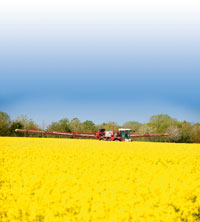Crop Watch: Dry weather proves testing

Erratic weed control, thin crops and dry weather are some of the problems testing our Crop Watch agronomists this week.
In Shropshire, early spring weed control had been patchy with tame oats and cleavers recovering from early applied mesosulfuron/iodosulfuron, said AICC agronomist Bryce Rham. “Pyroxsulam applications made in the first half of April are working well on broadleaved weeds, grassweeds and volunteer barley.”
Winter barley and wheat crops were thinner than usual due to the cold winter and plants being unable to get hold of applied nitrogen early enough, he said.
T2 fungicides were being applied in Suffolk and disease levels were relatively low, said Frontier agronomist Brian Ross. “Particularly where a good fungicide programme has been followed.”
Flower buds were starting to show in spring beans and most crops had emerged well, he said. “There are some very strong plant stands thanks mainly to some excellent seed-beds.” Weevils were still present in relatively high numbers, but crops were starting to grow away from damage, he said.
In the South, ProCam’s Nick Brown from Buckinghamshire said most wheat crops had received a T2 fungicide and the next concern would be orange blossom midge. “The use of pheromone traps to monitor numbers is a useful tool – traps should be in position as the boots split. If it stays hot and dry, ear emergence will happen quickly and crops will not be at the vulnerable stage for too long.”
Rape crops continued to flower well with forward crops approaching the end of flowering, he said. “Hopefully, not too many will require a second sclerotinia spray.” DK Cabernet would probably be the exception as it was still some time off the end of flowering, he said.
Final sprays had been applied to winter barley in North Yorkshire and some crops received a second growth regulator, said AICC agronomist Patrick Stephenson. Oilseed rape looked promising and although late frosts took some flowers, the hot spell allowed the crop recover, he said.
“Winter wheat looks well when I am driving by at 50mph. Sadly, I have to stop and walk the crops,” he said. “Open canopies are too common and weed re-growth will be an issue.”
Dry soils were making herbicide choices difficult for potato growers, said SAC’s John Sarup. “In some cases I suggest keeping the cost of the residual element down, while making sure the contact element is robust enough to see the crop through the ground. A post-emergence application of rimsulfuron (Titus) will then be required, but this is not an option for seed growers.”
Irrigation timing was crucial for common scab control and growers should keep a soil moisture deficit of 15-18mm during tuber initiation, he said.
Click below to read to full reports
Crop Watch North – Patrick Stephenson

